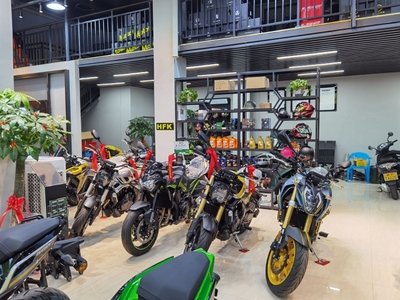
Motorcycle Customization: Essential Knowledge and Techniques
CustomStoreMCBikerMotorcycle customization is more than just upgrading parts; it’s an expression of personal style, a way to enhance performance, and a craft that requires both creativity and technical skills. Whether you're a beginner or a seasoned rider, understanding the basics of customization can help you build a bike that not only looks great but also suits your riding needs. In this guide, we’ll break down the essential knowledge and techniques required for motorcycle customization.
1. Understanding the Basics of Motorcycle Customization
Before diving into customization, it's important to understand the different aspects that can be modified on a motorcycle. Customization generally falls into three categories:
- Aesthetic Customization: Changing the bike’s appearance, such as paint jobs, decals, and custom seats.
- Performance Enhancement: Upgrading parts to improve speed, handling, and efficiency.
- Functional Modifications: Adjustments that improve comfort, safety, or practicality.
Each category serves a different purpose, and most riders combine all three to achieve their ideal build.
2. Choosing the Right Base Motorcycle
Not all motorcycles are equally suited for customization. Some popular choices for custom builds include:
- Cruisers (e.g., Harley-Davidson, Indian): Best for classic and chopper-style modifications.
- Café Racers (e.g., Honda CB series, Yamaha XS): Ideal for retro-styled, performance-focused builds.
- Adventure Bikes (e.g., BMW GS series, KTM Adventure): Built for rugged terrain with practical upgrades.
- Sport Bikes (e.g., Yamaha R1, Suzuki GSX-R): Modified for aerodynamics, speed, and aggressive styling.
Selecting the right base bike depends on your intended use, budget, and the level of customization you want to achieve.
3. Customizing the Motorcycle’s Appearance
Paint and Graphics
A fresh paint job is one of the simplest and most effective ways to personalize a bike. Popular options include:
- Solid Colors: Classic and sleek.
- Metallic Finishes: Adds depth and shine.
- Airbrushed Designs: Custom artwork and intricate details.
- Vinyl Wraps: A cost-effective alternative to painting.
Lighting Upgrades
Upgrading lights improves both aesthetics and visibility. Common modifications include:
- LED Headlights: Brighter and more energy-efficient.
- Custom Tail Lights: Enhancing rear visibility and style.
- Underglow Kits: Adds a bold, futuristic look.
Custom Seats
Comfort and style go hand in hand with seat customization. Options include:
- Leather vs. Synthetic: Leather offers durability and a premium feel, while synthetic materials are more weather-resistant.
- Low-profile Seats: Provide a sleeker look for café racers and bobbers.
- Heated or Gel Seats: Improve comfort for long-distance riders.
4. Performance Upgrades
Engine and Exhaust System
Upgrading the engine and exhaust enhances both power and sound. Popular modifications include:
- Performance Air Filters: Improve airflow and efficiency.
- Aftermarket Exhaust Systems: Increase horsepower and produce a richer sound.
- Fuel Management Systems: Optimize fuel-to-air ratio for better combustion.
Suspension and Handling
A well-tuned suspension significantly improves ride quality. Common upgrades include:
- Adjustable Rear Shocks: Offer customizable damping and preload settings.
- Inverted Forks: Provide better front-end stability.
- Steering Dampers: Reduce handlebar wobble at high speeds.
Brake System Enhancements
Stopping power is just as important as acceleration. Key upgrades include:
- Steel-Braided Brake Lines: Improve brake feel and durability.
- Larger Disc Rotors: Increase stopping power.
- Upgraded Calipers: Provide stronger and more consistent braking force.
5. Functional Modifications
Ergonomic Adjustments
Customizing a bike for better ergonomics ensures a more comfortable ride. Consider:
- Handlebar Adjustments: High-rise bars for cruisers, clip-ons for sport bikes.
- Footpeg Relocation Kits: Allow better positioning for different riding styles.
- Windshields and Fairings: Improve aerodynamics and reduce wind resistance.
Luggage and Storage Solutions
For long-distance riders, adding storage options is essential. Common solutions include:
- Saddlebags and Panniers: Offer extra storage without compromising style.
- Tank Bags: Easily accessible storage for essentials.
- Tail Racks and Top Cases: Provide additional carrying capacity.
Tires and Wheels
Choosing the right tires affects both performance and aesthetics. Key considerations include:
- Street Tires vs. Off-Road Tires: Choose based on terrain and riding conditions.
- Spoked Wheels vs. Alloy Wheels: Spoked wheels offer flexibility, while alloy wheels provide strength and modern styling.
6. Electrical System Modifications
Custom Gauges and Displays
Replacing the stock gauge cluster with a digital display or custom analog dials adds a unique touch. Options include:
- LCD/LED Dashboards: Offer real-time data and customization.
- GPS Integration: Essential for touring riders.
Sound Systems
For those who love music on the road, adding an audio system can enhance the riding experience. Common setups include:
- Bluetooth Speakers: Compact and weather-resistant.
- Helmet Communication Systems: Allow hands-free calls and music streaming.
7. Legal Considerations and Safety Compliance
Customizing a motorcycle comes with legal responsibilities. Be sure to:
- Check Local Regulations: Some modifications, like loud exhausts or underglow lights, may be restricted.
- Ensure Roadworthiness: Safety should never be compromised for aesthetics.
- Use DOT-Approved Parts: For helmets, tires, and lights.
8. DIY vs. Professional Customization
While many modifications can be done at home, some require professional expertise.
DIY Customization
- Pros: Cost-effective, hands-on learning experience.
- Cons: Time-consuming, requires tools and technical knowledge.
Professional Customization
- Pros: High-quality results, expert craftsmanship.
- Cons: More expensive, less personal involvement.
For major upgrades like frame modifications or engine tuning, seeking professional help is often the best choice.
Conclusion
Motorcycle customization is an exciting journey that blends creativity, technical knowledge, and personal expression. Whether you’re upgrading for style, performance, or comfort, understanding the basics ensures a successful build. With careful planning, the right tools, and a passion for riding, you can transform any motorcycle into a unique machine that reflects your personality and riding style.
Ready to start customizing? Gather your tools, choose your parts, and let your creativity take the lead on the open road!









